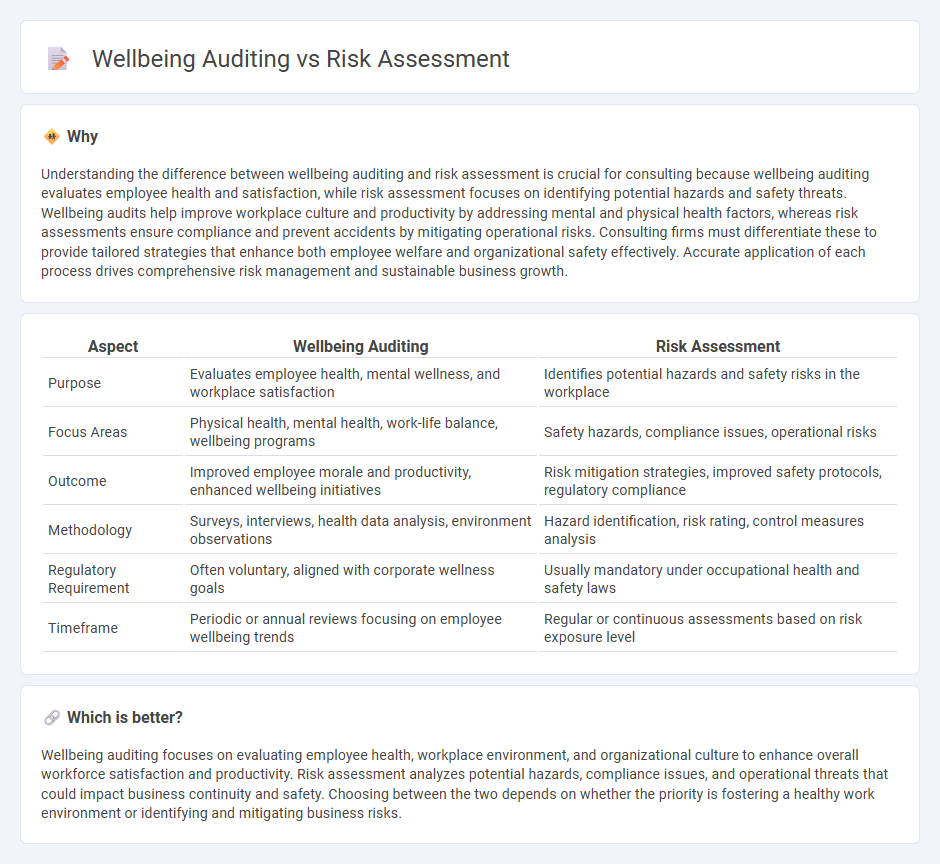
Wellbeing auditing focuses on evaluating employee health and workplace culture to enhance overall productivity and job satisfaction, whereas risk assessment identifies potential hazards to prevent accidents and ensure compliance with safety regulations. Companies investing in wellbeing audits often see reduced absenteeism and improved morale, contrasting with risk assessments that primarily mitigate financial and legal liabilities. Explore how integrating both approaches can create a safer, healthier, and more resilient organization.
Why it is important
Understanding the difference between wellbeing auditing and risk assessment is crucial for consulting because wellbeing auditing evaluates employee health and satisfaction, while risk assessment focuses on identifying potential hazards and safety threats. Wellbeing audits help improve workplace culture and productivity by addressing mental and physical health factors, whereas risk assessments ensure compliance and prevent accidents by mitigating operational risks. Consulting firms must differentiate these to provide tailored strategies that enhance both employee welfare and organizational safety effectively. Accurate application of each process drives comprehensive risk management and sustainable business growth.
Comparison Table
| Aspect | Wellbeing Auditing | Risk Assessment |
|---|---|---|
| Purpose | Evaluates employee health, mental wellness, and workplace satisfaction | Identifies potential hazards and safety risks in the workplace |
| Focus Areas | Physical health, mental health, work-life balance, wellbeing programs | Safety hazards, compliance issues, operational risks |
| Outcome | Improved employee morale and productivity, enhanced wellbeing initiatives | Risk mitigation strategies, improved safety protocols, regulatory compliance |
| Methodology | Surveys, interviews, health data analysis, environment observations | Hazard identification, risk rating, control measures analysis |
| Regulatory Requirement | Often voluntary, aligned with corporate wellness goals | Usually mandatory under occupational health and safety laws |
| Timeframe | Periodic or annual reviews focusing on employee wellbeing trends | Regular or continuous assessments based on risk exposure level |
Which is better?
Wellbeing auditing focuses on evaluating employee health, workplace environment, and organizational culture to enhance overall workforce satisfaction and productivity. Risk assessment analyzes potential hazards, compliance issues, and operational threats that could impact business continuity and safety. Choosing between the two depends on whether the priority is fostering a healthy work environment or identifying and mitigating business risks.
Connection
Wellbeing auditing systematically evaluates employee health and satisfaction metrics to identify potential risks affecting organizational performance. Risk assessment in consulting uses these insights to predict and mitigate issues such as burnout, absenteeism, and decreased productivity. Integrating wellbeing data with risk strategies enhances decision-making processes and fosters a resilient workplace culture.
Key Terms
**Risk Assessment:**
Risk assessment systematically identifies and evaluates potential hazards in the workplace to prevent accidents and ensure compliance with safety regulations. It involves analyzing risks related to physical, chemical, biological, and ergonomic factors that could impact employee health or organizational operations. Explore comprehensive strategies to enhance workplace safety through effective risk assessment methodologies.
Hazard Identification
Risk assessment centers on systematically identifying potential hazards that may cause harm in the workplace, prioritizing the evaluation of physical, chemical, biological, and ergonomic risks. Wellbeing auditing extends beyond hazard identification to include the evaluation of psychological and social factors affecting employees' overall health and productivity. Discover how integrating both approaches can enhance organizational safety and employee wellbeing.
Probability Analysis
Risk assessment centers on identifying potential hazards and calculating the probability of adverse events to implement effective mitigation strategies. Wellbeing auditing evaluates factors influencing employee health and satisfaction but typically integrates qualitative data alongside probability analysis to predict outcomes. Explore how probability analysis uniquely shapes both risk assessment and wellbeing auditing to enhance organizational resilience.
Source and External Links
Risk Assessment - This process involves identifying potential hazards and evaluating their likelihood and impact to implement mitigation strategies.
Risk Assessment: Process, Tools, & Techniques - This link provides an overview of the systematic process used to identify and analyze potential workplace hazards and risks.
Hazard and Risk - Risk Assessment - This webpage offers guidance on conducting a thorough workplace risk assessment to identify harmful situations and processes.
 dowidth.com
dowidth.com